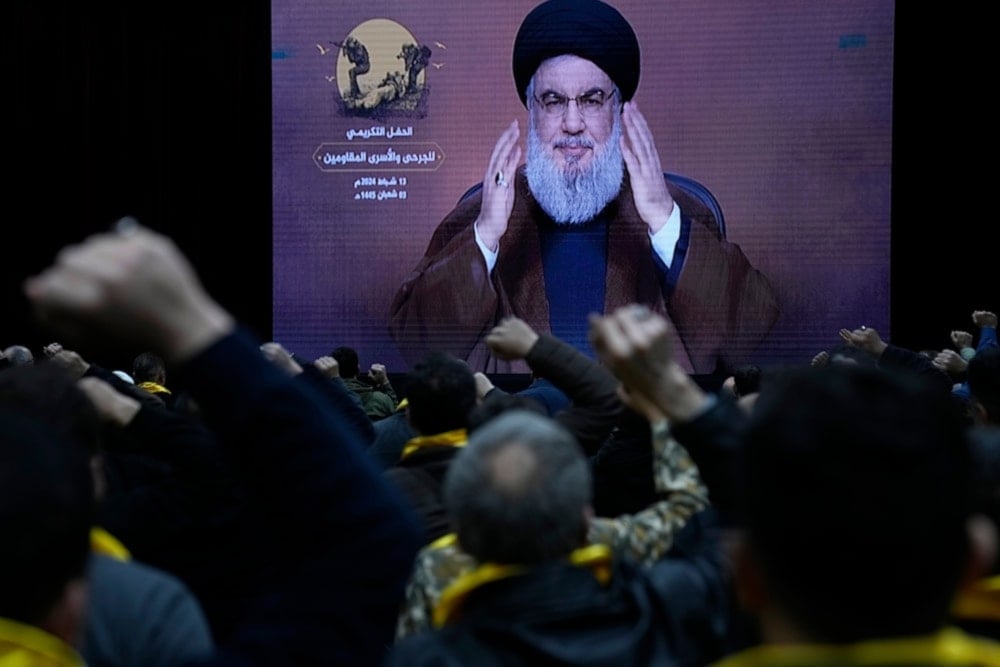Israeli Institute for Security: Hezbollah UAVs at advantage in North
According to an Israeli analyst, Hezbollah's UAVs have manifested flexibility of operations, lengthy activity times, and low costs.
-

Hezbollah supporters raise their fists and chant in support of Sayyed Hassan Nasrallah as he prepares to speak on the Day of the Wounded in the southern suburb of Beirut Lebanon on February 13, 2024 (AP)
According to the Israeli Institute for National Security Studies, the Lebanese resistance, Hezbollah, is at an advantage in the north due mainly to its unmanned aerial vehicles (UAV).
Hezbollah continues engaging Israeli military sites and settlements in support of the Palestinian people in Gaza and the Palestinian Resistance, as well as in response to the Israeli occupation's attacks on Lebanese villages and civilian homes in the country's south.
Hezbollah conducted several operations in support of the Palestinian people and their Resistance in the Gaza Strip on Sunday.
On Monday its fighters successfully shot down a Hermes 450 Israeli drone violating Lebanese airspace over the region of Iqlim al-Tuffah in South Lebanon, using a surface-to-air missile.
The vehicles have manifested in flexibility of operations, lengthy activity times, and low costs, allowing the fighters to use them as effective weapons of attack and intelligence gathering in the north.
The institute reported that Hezbollah is utilizing various types of drones for attacking the Israeli occupation forces (IOF) in addition to suicide attacks and intelligence gathering.
While the institute notes that Israeli air power is strong, it faces a disadvantage against these drones with their slow flight speed low altitude, and low radar.
Since there is no appropriate defense, these drones are infiltrating strategic locations, population centers, and military bases for intelligence or offensive purposes. Furthermore, in the third week of February 2024, two drones infiltrated into "Israel" and unexpectedly hit civilian targets without ever being detected.
The institute lists the characteristics of these drones as:
- Made in China or Iran, or self-made entirely
- Used for over 20 years for a variety of operations
- Notable particularly in long-range attack (2000km) and able to remain in the air for long times
- Ability to carry l=payloads of up to 150kg
Also worrying for the Israeli occupation is the suicide drones in the possession of Hezbollah based on the Ababil 2T, which carries a 20-40kg warhead, or its upgraded version, the Mirsad-1, which has a wide attack range and ability to carry large explosives.
The resistance also holds Ayoub or Mirsad-2 drones, used to collect visual and electronic intelligence or to track detection and attack systems.
The institute also notes that Iran has stealth drones, and has announced the manufacture of long-range drones equipped with jet engines. It warns that such equipment could appear on the battlefield in the future or in a regional conflict.
'Israel' concerned Hezbollah drones bypassing detection systems
Israeli media addressed on Tuesday the increasing number of incidents in which drones launched by Hezbollah infiltrated into the depths of the occupied territories without being detected, questioning whether the Resistance movement has found a gap in the Israeli army's interception and detection system.
In a serious incident earlier, a Hezbollah drone was found in the yard of Moshe Davidovich, the head of the "Mateh Asher" Regional Council and Confrontation Line Forum in northern occupied Palestine.
Israeli media quoted Davidovich as saying that the UAV had surpassed all anti-air and detection systems and mechanisms.
This evidence took place just one day after a drone made its way uninterrupted 50 kilometers deep into northern occupied Palestine and reached Tabaraya.
Israeli Channel 12 reported that "Hezbollah's drone incident .. is an additional example of the weakness of the security institution in detecting relatively small aerial objects."
For his part, the military affairs correspondent for the Israeli channel KAN warned that Hezbollah's drones crossing into the north undetected raises serious questions about the current systems in place.
Itay Blumenthal pointed out that "officials in the Air Force are talking about complex events and a great challenge in detecting Hezbollah's aerial objects, as they generally fly at a low altitude."

 4 Min Read
4 Min Read








